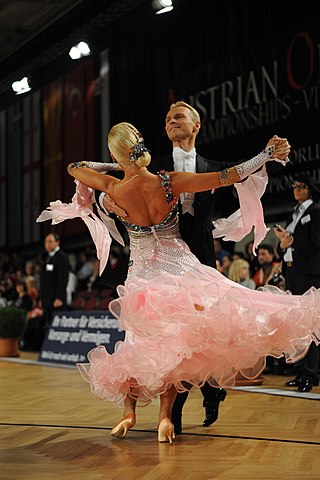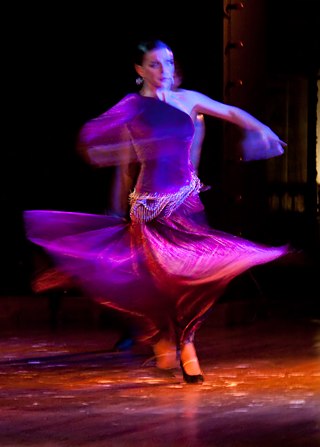
Ballroom dance is a set of partner dances, which are enjoyed both socially and competitively around the world, mostly because of its performance and entertainment aspects. Ballroom dancing is also widely enjoyed on stage, film, and television.
In some types of partner dance, lead and follow are designations for the two dancers' roles in a dance pairing. The leader is responsible for guiding the couple and initiating transitions to different dance steps and, in improvised dances, for choosing the dance steps to perform. The leader communicates choices to the follower, and directs the follower by means of subtle physical and visual signals, thereby allowing the pair to be smoothly coordinated.
Dance moves or dance steps are usually isolated, defined, and organized so that beginning dancers can learn and use them independently of each other. However, more complex movements are influenced by musicality and lyrical relevance to express emotions or refer to a message. Dance moves tend to emphasize the concepts of lead and follow and connection.

A redowa is a dance of Czech origin with turning, leaping waltz steps that was popular in European ballrooms.
This is a list of dance terms that are not names of dances or types of dances. See List of dances and List of dance style categories for those.

In ballroom dancing, directions of progressive movement, in particular directions of steps, can be indicated either in relation to the room or in relation to the body position. Directions of turns, although there are only two of them, may also be indicated in several ways.
Because ballet became formalized in France, a significant part of ballet terminology is in the French language.

Dips are common to many partner dance styles.
The closed change is a Pre-Bronze, or newcomer waltz figure, performed in closed position. Changes may start of the right foot or left foot, moving forward or backward. This makes four different types of closed changes. Combining two changes results in a box step. In right changes the man starts from the right foot, while in left ones the man starts from the left foot.
Samba de Gafieira is a partner dance to various Brazilian samba musical rhythms. Unlike street and club forms of Brazilian samba, it evolved as a ballroom dance.

A handspring is an acrobatic move in which a person executes a complete revolution of the body by lunging headfirst from an upright position into an inverted vertical position and then pushing off from the floor with the hands so as to leap back to an upright position. The direction of body rotation in a handspring may be either forward or backward, and either kind may be performed from a stationary standing position or while in motion. Body movement may be terminated upon completion of a handspring, or the performer's momentum may be leveraged so as to immediately perform another handspring or other rotational move.

The chassé is a dance step used in many dances in many variations. All variations are triple-step patterns of gliding character in a "step-together-step" pattern. The word came from ballet terminology.

Motion, the process of movement, is described using specific anatomical terms. Motion includes movement of organs, joints, limbs, and specific sections of the body. The terminology used describes this motion according to its direction relative to the anatomical position of the body parts involved. Anatomists and others use a unified set of terms to describe most of the movements, although other, more specialized terms are necessary for describing unique movements such as those of the hands, feet, and eyes.
Botafogo, also sometimes spelt as Bota-fogo or Bota Fogo, is a dance step in Samba. Depending on relative positions and handholds, there are several versions of Botafogos while the basic footwork technique is the same. The name comes from Botafogo place in Rio de Janeiro, Brazil.
The following is a glossary of figure skating terms, sorted alphabetically.
Bachata is a style of social dance from the Dominican Republic which is now danced all over the world. It is connected with bachata music.
The promenade position is a dance position in ballroom and other dances. It is described differently in various dance categories.

In dance and gymnastics, a turn is a rotation of the body about the vertical axis. It is usually a complete rotation of the body, although quarter (90°) and half (180°) turns are possible for some types of turns. Multiple, consecutive turns are typically named according to the number of 360° rotations.
Figures of Argentine tango are elements of Argentine tango.









